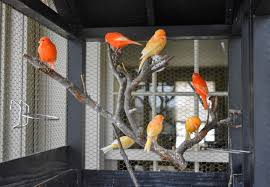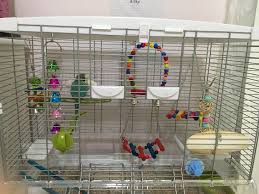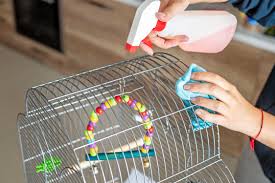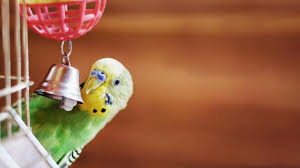
An essential aspect of having a bird as a pet is setting up your bird’s cage. Not only is it a matter of “where the cage fits”, but it also provides the best environment for your birds’ physical and mental well-being
First off, let’s avoid those drafty areas, windows with intense sunbeams, and spots where the family buzz is non-stop. Drafts can chill your bird, while too much direct sun can lead to overheating. And while birds enjoy social interaction, they also need their downtime away from constant noise and movement.
Ideal placement strikes a balance. Your bird should be able to perch and gaze at family activities without being in the thick of it. This can reduce stress and encourage a sense of belonging without overwhelming your pet. It’s a bit like having a room with a view rather than being on the dance floor 24/7.
And don’t forget about safety and maintenance. Keeping the cage a few inches from the wall can prevent accidents and make it easier to clean those hard-to-reach spots. Imagine trying to retrieve a stray toy or feather from a tight space – not fun for you or your bird. A plastic floor pad below the cage is a lifesaver for your flooring and makes spill cleanup a breeze.
Now, with the cage securely and thoughtfully placed, you’re on your way to crafting a sanctuary that’s a feather above the rest. But remember, the spot you choose impacts more than just sociability. In the next section, I’m going to guide you through the ins and outs of achieving the perfect lighting and climate for your winged companion.
Lighting and Climate: Creating a Cozy Habitat
When you’re setting up your bird’s cage, think about their lighting and climate needs as though you’re arranging a small, feathery version of your own living space. Birds are sensitive creatures, and getting the lighting and temperature just right matters for their well-being.

Natural light does wonders for your bird’s health—it helps regulate their sleep cycle, and plays a role in their mood and behavior. But, and this is key, you don’t want to place their cage directly in sunlight as it might get too hot, and a dark corner can be a gloomy spot for a bird. Find a happy medium where sunlight filters in, but without the harsh glare.
Here’s where you’re going to hit a few common pitfalls—those pesky heating and cooling vents, heaters, and radiators. Your bird’s comfort zone is likely different from yours, and sudden changes can be stressful. Make sure their environment stays as consistent as possible by keeping the cage away from direct blasts of air or heat sources.
Temperature-wise, most birds prefer it much like Goldilocks—not too hot, not too cold, but just right. Depending on the species, a regulated temperature is essential for your feathered buddy to feel at home. If you’re not sure about the sweet spot, check in with a vet or a reliable bird care guide.
So here’s what I recommend: position the cage in a place where there’s a good amount of indirect natural light and where temperature shifts are minimal. It’s all about finding that perfect climate where your bird can thrive, sing, and maybe do a happy little feather dance.
Now, let’s transition into the next essential aspect of your bird’s living quarters: the setup of food and water bowls and the perches. These elements are crucial for your bird’s daily activities and overall health.
Essentials of Feeding Station and Perch Placement
You’ve nailed down the perfect location for your bird’s cage, now it’s time to talk about where you’ll place their food and water bowls. Proper placement isn’t just about convenience; it’s crucial for your bird’s health. Bowls should be sitting pretty where the perches are easily accessible, ensuring that your bird doesn’t have to be an acrobat to get to its meals. And you’re going to want to keep them far from where droppings might contaminate the food.
When it comes to bowls, ease of cleanliness is key. You’ll be washing and refilling these daily, so choose bowls that snap in and out of their holders with ease. This isn’t just about keeping things tidy; it’s about keeping your bird in peak health. Contaminated water or old food can lead to illnesses, which is the last thing you want.
Let’s chat about perches. Size matters here, folks. If you want your bird to be comfortable, select perches that match up with its size. Think of it like shoes: you wouldn’t wear ones that are too small, right? Birds need to have a grip that feels natural. And it’s not just size that counts. Variety is the spice of life! Offering an assortment of textures – natural branches, like manzanita, can be perfect – helps keep your bird’s feet healthy.
Now, let’s move into the fun stuff. In the next section, we’ll dive into playtime essentials and the down-and-dirty of cage maintenance. Get ready to make your bird’s home not just comfortable, but downright delightful.
Enhancing Your Bird’s Life: Playtime and Cage Maintenance
Playtime isn’t just a luxury; it’s a crucial part of your bird’s day. I’m going to show you how to strike the right balance with toys in your bird’s cage to enhance their well-being without overwhelming them. Choose toys wisely – they should be safe, made of appropriate materials, and offer a variety of textures.

You might also want to consider a cage that comes with a playpen on top. It’s a fantastic way for your bird to have some monitored fun outside the cage. This extra space can make all the difference in their mood and overall health.
Now, let’s talk about maintenance, because it’s as important as the setup itself. Daily tasks like changing the cage liner keep the environment clean and disease-free. Besides, washing and refilling the food and water bowls each day ensures your bird is eating and drinking from clean surfaces. Don’t forget about the perches and toys; as they show signs of wear, be sure to replace them to prevent possible injuries or ingestion of broken pieces.
Summing up, setting up your bird’s cage is about creating a habitat that catinateers to their comfort and stimulates their curiosity. Regular upkeep makes the cage a sanctuary for your feathered companion. I really hope that your efforts in arranging and maintaining the perfect bird cage environment will foster a strong bond between you and your bird, ensuring they lead a happy, healthy life. Keep in mind, your first attempt doesn’t need to be your last – you can always adjust your approach down the road. Here’s to joyful chirps and contented tweets from your winged friend!


Thank you for this comprehensive guide. I never thought so much about the location, and have always just made sure that the birds were not in a draft, as I know they hate that.
When buying a cage it is essential to see if it is easy to clean. The more attractive ones tend to have more nooks and crannies making them more difficult to clean. I have learned my lesson the hard way.
I love the idea of a cage that opens out on top. Would this type of cage also suit buggies?
Dear Michel,
Thank you for sharing your thoughts and experiences! You’re absolutely right about the importance of considering ease of cleaning when choosing a bird cage. A cage with lots of nooks and crannies might look appealing but can be a hassle to maintain. As for cages that open on top, they can be great for budgies too! Budgies are curious birds and having a top-opening cage can make it easier to interact with them and clean their environment. It’s always good to find a balance between functionality and attractiveness when selecting a cage. It is also important to consider the safety of the Budgies while the cage is open.
Kind regards Tim